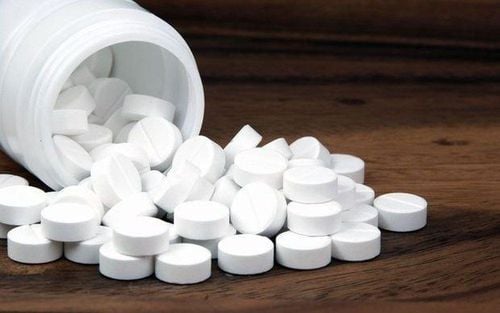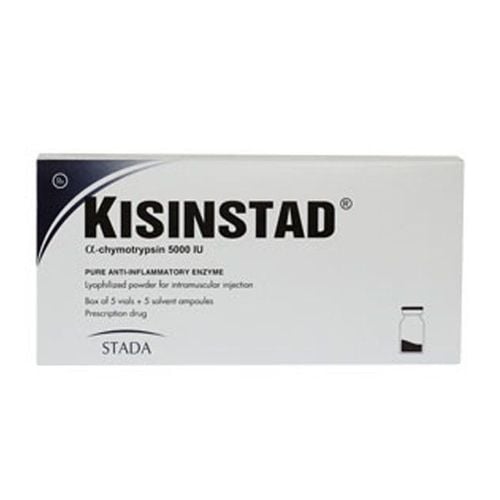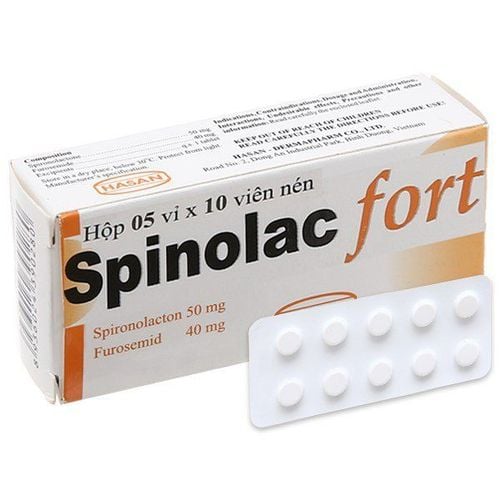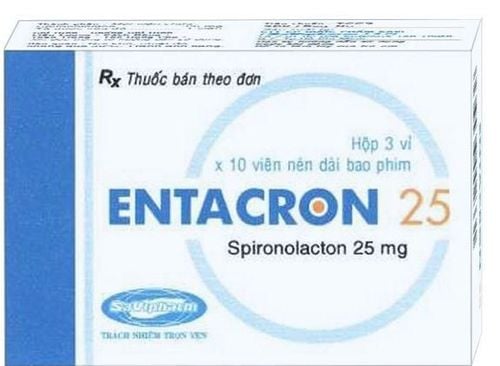This is an automatically translated article.
Thiazifar contains the main active ingredient is hydrochlorothiazide, a thiazide diuretic. The drug has the effect of increasing the excretion of sodium and water, so it is used in the treatment of many diseases such as hypertension and edema.
1. What is Thiazifar?
Thiazifar contains the active ingredient hydrochlorothiazide, a thiazide diuretic. The mechanism of action of hydrochlorothiazide is to inhibit the reabsorption of sodium ions in the distal tubule, thereby leading to increased sodium and water excretion. The excretion of other electrolytes is also increased, especially potassium and magnesium, but the excretion of calcium is decreased. Thiazide diuretics have a moderate diuretic effect, since about 90% of sodium ions have been reabsorbed before reaching the distal convoluted tubule, the site of its predominant action. Hydrochlorothiazide has a hypotensive effect by reducing plasma volume. The hypotensive effect will then depend on a decrease in peripheral vascular resistance, through gradual adaptation of blood vessels to hyponatremia. Therefore, the antihypertensive effect of the drug usually appears slowly after 1 to 2 weeks, while the diuretic effect occurs more quickly (can be seen as soon as a few hours of use). Hydrochlorothiazide is rapidly absorbed after oral administration, with peak concentrations occurring about 2 hours after dosing. Food has little effect on the absorption of hydrochlorothiazide. The half-life varies from subject to subject, usually from about 6 to 15 hours. Hydrochlorothiazide is eliminated mainly as unchanged drug.
2. What are the indications of Thiazifar 25 mg?
Thiazifar 25 mg is indicated in the following cases:
Edema due to heart failure and other causes (edema due to kidney disease, liver disease, corticosteroids or estrogen). Hypertension used alone or in combination with other antihypertensive drugs such as calcium channel blockers, angiotensin converting enzyme inhibitors (ACEi).
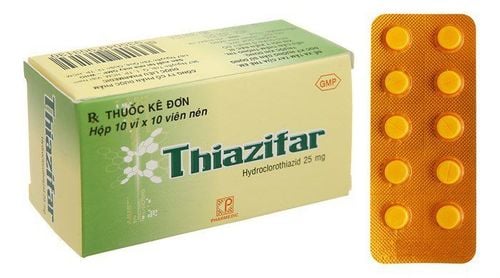
Thiazifar là một trong các thuốc lợi tiểu nhóm thiazide
3. Dosage of the drug thiazifar
Thiazifar should be initiated at the lowest possible dose. Dosage should be based on individual patient response and tolerability to achieve maximum therapeutic efficacy while minimizing adverse events. Thiazifar can be taken once or twice, with or without food. Dosage depends on the medical condition, specifically as follows:
Treatment of edema: Initial dose is 50-100 mg/day, can be up to 200mg/day. Maintenance dose ranges from 25 to 50 mg/day or every other day. Treatment of hypertension: The usual dose is 12.5 mg or 25 mg/day, maximum effect is achieved about 3 to 4 weeks after dosing. If blood pressure does not fall to the target level at 25 mg/day, other antihypertensive agents should be combined. Patients with renal impairment: For patients with mild to moderate renal impairment, no initial dose adjustment is required. Thiazifar is contraindicated in patients with severe renal impairment and anuria. Hepatic impairment: In patients with mild to moderate hepatic impairment, no initial dose adjustment is required. For patients with severe hepatic impairment, Thiazifar should be used with caution.
4. What to do in case of overdose or missed dose?
Thiazifar overdose often causes electrolyte depletion (low potassium, hypochloremia and hyponatremia), dehydration due to excessive diuresis. If the patient is taking the drug digitalis (digoxin), hypokalemia may cause cardiac arrhythmias. The management of Thiazifar overdose is symptomatic and supportive treatment. If an overdose has occurred, the patient should be induced vomiting or gastric lavage. Doctors may prescribe rehydration, electrolytes. Give oxygen to patients with respiratory failure if necessary.
If you forget to take a dose of Thiazifar, take it as soon as you remember. However, if it is almost time for your next dose, skip the missed dose and take your next dose as scheduled. Note: Do not take a double dose to make up for the missed dose.
5. What are the side effects of Thiazifar?
Common, ADR > 1/100
Whole body: dizziness, dizziness, fatigue, headache. Cardiovascular: Orthostatic hypotension. Metabolic: Hypokalemia, hyperuricemia, hyperglycemia, hyperlipidemia Uncommon, 1/1000 < ADR < 1/100
Cardiovascular: Orthostatic hypotension, arrhythmia. Gastrointestinal: Nausea, vomiting, stomach irritation, loss of appetite, diarrhea, constipation Skin: Urticaria, rash. Metabolism: Hypomagnesaemia, hyponatremia, hypercalcemia, hypochloremia, alkalosis. Rarely, ADR < 1000
Systemic: Anaphylactic reactions, fever. Blood and lymphatic system: Leukopenia, thrombocytopenia, hemolytic anemia, aplastic anemia. Nervous: sleep disturbances, paresthesia, depression. Skin: Vasculitis, rash, hemorrhage, erythema multiforme, dermatitis, toxic epidermal necrolysis, Stevens-Johnson syndrome. Liver: Cholestatic jaundice, pancreatitis, hepatitis,. Respiratory: Shortness of breath, pneumonia, respiratory failure. Genitourinary: Renal failure, interstitial nephritis, impotence. Eyes: Blurry (transient) vision. When experiencing side effects of the drug, the patient should stop using the drug and notify the doctor or go to the nearest medical facility for treatment.

Thiazifar có thể gây rối loạn giấc ngủ ở một số người bệnh dùng thuốc
6. What are the precautions when taking Thiazifar?
Thiazifar 25 mg is contraindicated in the following cases: allergic to any ingredient of the drug and sulfonamide derivatives, patients with gout, hyperuricemia, Addison's disease, anuria, hyperuricemia serum calcium, severe liver and kidney failure. Adrenal insufficiency: Avoid the use of diuretics to treat hypertension in patients with primary adrenal insufficiency (Addison's disease). For the treatment of hypertension, therapies such as glucocorticoid/mineralocorticoid correction and/or the use of other antihypertensive agents may be used. Ascites due to cirrhosis: Use with extreme caution or avoid hydrochlorothiazide in the management of ascites due to cirrhosis because it can lead to rapid hyponatremia when used in combination with spironolactone and furosemide. Use in patients with pre-diabetes or diabetes because the drug can increase blood glucose Hepatic impairment: Use with caution in patients with severe hepatic impairment, advanced or severe liver disease as it may lead to Electrolyte imbalance, hepatic encephalopathy Hypercholesterolemia : Use with caution in patients with moderate or high cholesterol levels because the drug may increase cholesterol Parathyroid disease: Thiazide diuretics increase serum cholesterol levels. blood calcium due to decreased calcium excretion. Pathological changes in the parathyroid glands with hypercalcemia and hypophosphataemia have been observed with prolonged use. Use should be discontinued prior to testing of parathyroid function. Renal impairment: Possible side effects such as uremia in patients with impaired renal function. Avoid in severe kidney disease because the drug will not be effective. Surgical patients: If used on the morning of surgery, hydrochlorothiazide may cause fluid volume changes and blood pressure may be unstable during anesthesia. Thiazides may cause hypokalemia or worsen hypokalemia in patients with renal disease or renal dysfunction. Hypokalemia in high-risk subjects such as the elderly, malnourished, patients taking digoxin, cirrhotic patients with edema and ascites,... Hypokalemia may increase cardiotoxicity of digitalis and the risk of cardiac arrhythmias, extreme caution should therefore be exercised. Hydrochlorothiazide is a sulfonamide. Therefore, cross-reactivity with other sulfonamides, especially antibiotics, may occur. This cross-allergic reaction is still theoretical and of no clinical value. Ability to drive and use machines: There is no evidence that the drug can affect the ability to drive and use machines. Pregnancy: Hydrochlorothiazide crosses the placenta. Maternal use of the drug can cause neonatal jaundice, thrombocytopenia and other adverse effects observed in adults. Therefore, this group of drugs should be avoided during the last 3 months of pregnancy. Treatment of edema associated with chronic heart failure during pregnancy is similar to that for nonpregnant patients. Thiazide diuretics may be considered for the treatment of edema due to heart failure in pregnant patients, but should be used with caution, as they may reduce placental blood flow. Lactation: Hydrochlorothiazide is excreted in human milk. Because of the potential for serious adverse reactions in the nursing infant, the manufacturer recommends that a decision be made whether to discontinue nursing or to discontinue the drug, taking into account the importance of treatment to the mother. Hydrochlorothiazide is considered compatible with breast-feeding (WHO 2002). However, thiazide diuretics have the potential to decrease lactation and inhibit lactation and should be avoided when possible. Drug Interactions: Using certain drugs with hydrochlorothiazide may alter its effectiveness or increase side effects. For example, when hydrochlorothiazide is used together with alcohol, barbiturates, narcotic hypnotics, orthostatic hypotension may occur. Concomitant use of hydrochlorothiazide with corticosteroids and ACTH may increase electrolyte loss, especially hypokalemia. Therefore, you need to inform your doctor or pharmacist about all the medicines you are taking so that they can be advised and adjusted accordingly. Summary. Thiazifar is a diuretic that can be used to treat edema and hypertension. The drug can cause many side effects on circulation, metabolism, electrolytes, ... Therefore, patients should not self-medicate but need to consult a doctor or pharmacist.
Follow Vinmec International General Hospital website to get more health, nutrition and beauty information to protect the health of yourself and your loved ones in your family.
Please dial HOTLINE for more information or register for an appointment HERE. Download MyVinmec app to make appointments faster and to manage your bookings easily.




